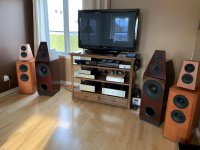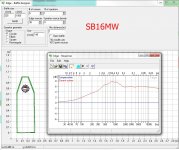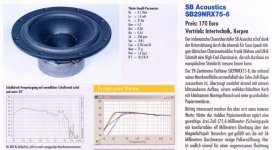Hi Bassivus,
are you able to draw a conclusion about the sound of your, beautifully made, speakers?
I have an interest in the design.
Thanks
Hello,
Speakers are now completely broken in and I can say it really takes a while. I feel like that curve is logarithmic
Pros: Great coherence, tonality. I felt that mid is a bit recessed so I have paralleled resistor lowering the value 10% and it opened it just the right amount.
After a lot of trial and error in positioning I got a nice width and depth in soundstage but still not the best I have heard. I am experimenting on bypass caps and got some really great results, but it is still ongoing process. Top kit with Alumen caps was to expensive for me but I guess it is worth to have at least on tweeter. Copper foil 0,1uF bypass cap gave me a great satisfaction.
I believe phase responses are really taken care(some cons read latter), as in my reference track for it Roger Waters album "Amused to Death" track "Ballad of Bill Hubbard" the dogs in the beginning of track are barking from my back right and the radio is on my left, completely out of reality space, almost like that I'm listening to surround.
This speakers are definitively a keeper but I feel there is still place for improvement with finetuninng XO.
Cons: It is a big speaker and that 10 inch bass needs SPACE! I have them in my living room of app. 22sqm but I find it small for them. I had really big 65Hz peaks. I have tried DSP via Roon Player but as all its a compromise. At this moment I'm listening with port stuffed with small amount of fluffed damping stuff. I'm planning to try putting some L pad to control the room gain on bass. Although 22sqm is not really small I am convinced that I need at least 1,5m Longer room to get a really good soundstage and less peaks in bass region. I would also mention in cons that the 14 deg. panel tilt has some cons that you can hear in stand up sit down test. It surely does the time alignment but in room it makes placement even harder. Also I'm measuring some bump in 5k region that is caused by sharp baffle edges, which was my unwilling compromise with craftsman that did the finish for me.
And lastly I have to say I'm disappointed how I literally got "kicked in butt" by Troels after I politely asked if I could have his in-cabinet-driver-measurements, so I could try fine tuning crossover for my room and taste. He got really mad and called me arrogant for even asking... so don't expect to get any help there.
If you wish to have my building plans and CNC files please contact me on PM
Cheers

Last edited:
Hello Bassivus
Thanks for your comments on the SBA-10.
I got mine completed after more than one year. The cabinet was done mostly by some friends of mine. This is the more simple version of the cabinets.
After more than about 400 hours of listening I find that the speaker has great qualities but like you I can hear a bump in maybe the same frequency region (although not measured). It is more evident on rock music style where these frequency are more dominant. Listening to jazz or soft music is ok though.
Like you I have quit discussing with Troels based on his negative response about the issue I have.
I did not want to do that but since I also listen a lot to progressive rock music I had to try to fix the issue. I have tried to play with some simple fix to the hi frequency crossover but still not perfect to me...
I have also level 2 crossover. If you can pm me on your crossover mod done or else it would be appreciated.
Thanks
Fab
Thanks for your comments on the SBA-10.
I got mine completed after more than one year. The cabinet was done mostly by some friends of mine. This is the more simple version of the cabinets.
After more than about 400 hours of listening I find that the speaker has great qualities but like you I can hear a bump in maybe the same frequency region (although not measured). It is more evident on rock music style where these frequency are more dominant. Listening to jazz or soft music is ok though.
Like you I have quit discussing with Troels based on his negative response about the issue I have.
I did not want to do that but since I also listen a lot to progressive rock music I had to try to fix the issue. I have tried to play with some simple fix to the hi frequency crossover but still not perfect to me...
I have also level 2 crossover. If you can pm me on your crossover mod done or else it would be appreciated.
Thanks
Fab
Attachments
Last edited:
After more than about 400 hours of listening I find that the speaker has great qualities but like you I can hear a bump in maybe the same frequency region (although not measured).
I have a hypothesis that the high frequency problem with this speaker may be due to the very low crossover frequency, which is also low sloped.
A 1-inch dome without a waveguide can not be connected to a 6-inch mid so that there is no difference in directivity, no matter how low you want to cross, but in this direction you can easily reach the limits of the tweeter's capabilities, which is not surprisingly their lower end, where the non-linearities are high without exception, producing harmonic and other distortions.
Maybe you can hear that too, plus an usual lower treble bloom in the power response due to low directivity of the tweeter in this region.
The Satori mid is good to 3kHz, so I think the crossing point would be much better between say 2.5-3kHz.
I write this without hearing this speaker, so treat this comment in this way.
Denes
I'd like to see those measurements, gated if possible. Also, i'd like to see measurements to at least 60 degrees off axis in 10 degree increments just to make sure the problem is diffraction. If that's the problem* it'll disappear off axis.
*Problem that is diffraction related with tweeters mounted on the flat baffle is usually dip on axis, not peak.
*Problem that is diffraction related with tweeters mounted on the flat baffle is usually dip on axis, not peak.
Last edited:
TG's simulation shows that obviously baffle effect and directivity of midrange have not been compensated - look at mid's response. In result, even on-axis response drops down just above 1kHz. Timing is propably ok because of tilted baffle.
Sadly I don't know how to fix that in a passive xo, but I guess that just smaller serial L3 value first, then different shunt?
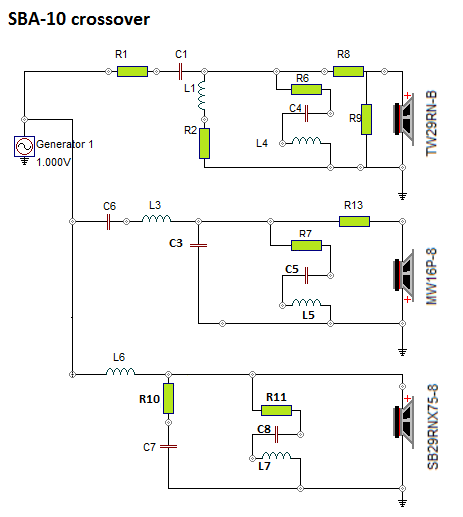
Sadly I don't know how to fix that in a passive xo, but I guess that just smaller serial L3 value first, then different shunt?

Attachments
Last edited:
Hello everybody!
I believe this discussion has got a bit off track. I have stated that I hear and measure some issues around 6kHz region but in my case it is minor.
Since I don't own anechoic chamber I can not tell for sure where it comes from. Since TG SBA10 share many similarities with JB Kairos 3way and after reading JB Kairos write-up showing baffle bump at 1.2K with paralell with 9" baffle (which he cleverly used to compensate mid dip in that region), I came to conclusion it could come from much narrower SBA baffle. Also TG has some rounding on edges there. I did some simulations in Virtuix cad2 and it confirmed it...when rounded edges are simulated no problem, that's all.
I have to say that I find that bump one of the least significant problems. Much bigger problem is room gain from that 10" bass.
I will probably do some rounding and it will resolve this issue...
I also want to state that despite what I commented on cons and I might left the impression it's bad, it's not. it IS A GOOD speaker after all. But in DIY we like to play arond stuff. Don't we?
I believe this discussion has got a bit off track. I have stated that I hear and measure some issues around 6kHz region but in my case it is minor.
Since I don't own anechoic chamber I can not tell for sure where it comes from. Since TG SBA10 share many similarities with JB Kairos 3way and after reading JB Kairos write-up showing baffle bump at 1.2K with paralell with 9" baffle (which he cleverly used to compensate mid dip in that region), I came to conclusion it could come from much narrower SBA baffle. Also TG has some rounding on edges there. I did some simulations in Virtuix cad2 and it confirmed it...when rounded edges are simulated no problem, that's all.
I have to say that I find that bump one of the least significant problems. Much bigger problem is room gain from that 10" bass.
I will probably do some rounding and it will resolve this issue...
I also want to state that despite what I commented on cons and I might left the impression it's bad, it's not. it IS A GOOD speaker after all. But in DIY we like to play arond stuff. Don't we?
Hi, 6kHz might sound hard because of recessed lower treble... Typically directivity is minimal around 6-8kHz too in this kind of baffles.
I use that same SB29NRX-75 woofer too, but in sealed box and some eq. Your room looks narrow, and if walls are brick, there is lots of boost. Easy to try blocked BR port! At my daughter's apartment 20Hz gets boosted from a lateral mode! Check the latest measurements in the gallery!
I use that same SB29NRX-75 woofer too, but in sealed box and some eq. Your room looks narrow, and if walls are brick, there is lots of boost. Easy to try blocked BR port! At my daughter's apartment 20Hz gets boosted from a lateral mode! Check the latest measurements in the gallery!
I have a hypothesis that the high frequency problem with this speaker may be due to the very low crossover frequency, which is also low sloped.
A 1-inch dome without a waveguide can not be connected to a 6-inch mid so that there is no difference in directivity, no matter how low you want to cross, but in this direction you can easily reach the limits of the tweeter's capabilities, which is not surprisingly their lower end, where the non-linearities are high without exception, producing harmonic and other distortions.
Maybe you can hear that too, plus an usual lower treble bloom in the power response due to low directivity of the tweeter in this region.
The Satori mid is good to 3kHz, so I think the crossing point would be much better between say 2.5-3kHz.
I write this without hearing this speaker, so treat this comment in this way.
Denes
I just analyzed this design using PCD ( I captured FRD and ZMA from Troels measurements) and there are two problems with this crossover:
1. 1600Hz is too low for the total (acoustical+electrical) transfer function
2. Even those this is a high bandwidth tweeter, the output must taper much more rapidly on the leading edge or distortion will rise dramatically (audible)
Therefore I agree with you, ~2,500 is great place to start and that is what I have been working on: 1st order electrical on the woofer, 3 order electrical on the tweeter.
Troels is welcome to come on the forum and challenge me, but he can't challenge the problems that those who have built it are having.
Cheers,
Greg
SBA10 sound demo
Here is the sound demo of my system:
SBA10 Sound Demo by Bassivus | Free Listening on SoundCloud
It was recorded with cheap Tascam DR-05 and only alterations done is cutting tracks so that I don't violate copyrights.
It's fairly long so if you don't like the track skip, there is plenty.
Here is the sound demo of my system:
SBA10 Sound Demo by Bassivus | Free Listening on SoundCloud
It was recorded with cheap Tascam DR-05 and only alterations done is cutting tracks so that I don't violate copyrights.
It's fairly long so if you don't like the track skip, there is plenty.
I just analyzed this design using PCD ( I captured FRD and ZMA from Troels measurements) and there are two problems with this crossover:
1. 1600Hz is too low for the total (acoustical+electrical) transfer function
2. Even those this is a high bandwidth tweeter, the output must taper much more rapidly on the leading edge or distortion will rise dramatically (audible)
Therefore I agree with you, ~2,500 is great place to start and that is what I have been working on: 1st order electrical on the woofer, 3 order electrical on the tweeter.
Troels is welcome to come on the forum and challenge me, but he can't challenge the problems that those who have built it are having.
Cheers,
Greg
I concur. If your music is single instrument at low volumes, you might get away with it. But a lot of high energy 1-3KHz records played at volume will stress a 1" dome tweeter at a sub 2KHz XO - especially low order slope.
As you turn the music up - you'll hear your treble compress / dynamics go.
..And lastly I have to say I'm disappointed how I literally got "kicked in butt" by Troels after I politely asked if I could have his in-cabinet-driver-measurements, so I could try fine tuning crossover for my room and taste. He got really mad and called me arrogant for even asking... so don't expect to get any help there.
..Like you I have quit discussing with Troels based on his negative response about the issue I have.
Yeah, that's not good.
I've no problem that he offers his designs on a commercial basis (..unlike more than a few in forums like these).
But if you are going to do that - you should act in a professional manner. It's easy enough to simply not respond to a particular topic (perhaps with a gentle decline to do something).. but calling someone arrogant: that's a pretty sh!tty thing to do.
It also "sounds" as if it's a recurring problem. A one-off bad day is going to happen, but more than one person having similar problems indicates a problem.
(..I really don't care that it's happening with one design, that it's happening at all is pretty poor.)
Last edited:
I concur. If your music is single instrument at low volumes, you might get away with it. But a lot of high energy 1-3KHz records played at volume will stress a 1" dome tweeter at a sub 2KHz XO - especially low order slope.
As you turn the music up - you'll hear your treble compress / dynamics go.
I agree on general rules that you talk about...
BUT you have missed some important "details".
First SATORI TW29RN is not a 1" dome as first denibeni states but slightly bigger ring radiator.
Secondly it is almost 10db attenuated in crossover to mach the rest of drivers. So it never goes to its limits.
Third this crossover is not simple low order slope it is almost third order as notch filter makes slope steeper than its already second order.
Both JB and TG crossed it at similar point, so...
Yeah, that's not good.
I've no problem that he offers his designs on a commercial basis (..unlike more than a few in forums like these).
But if you are going to do that - you should act in a professional manner. It's easy enough to simply not respond to a particular topic (perhaps with a gentle decline to do something).. but calling someone arrogant: that's a pretty sh!tty thing to do.
It also "sounds" as if it's a recurring problem. A one-off bad day is going to happen, but more than one person having similar problems indicates a problem.
(..I really don't care that it's happening with one design, that it's happening at all is pretty poor.)
Absolutely so! I have a feeling that TG curses the day when he turned to commercial kits, as people as they rightfully feel-expect more support and ask for more.
I agree on general rules that you talk about...
BUT you have missed some important "details".
First SATORI TW29RN is not a 1" dome as first denibeni states but slightly bigger ring radiator.
Secondly it is almost 10db attenuated in crossover to mach the rest of drivers. So it never goes to its limits.
Third this crossover is not simple low order slope it is almost third order as notch filter makes slope steeper than its already second order.
Both JB and TG crossed it at similar point, so...
Yes I was wrong. You are correct. I'm looking forward to buying a pair for my next project and finding the sweet spot. Paired though with an mr13p you do have the flexibility to play higher if you want.
Absolutely so! I have a feeling that TG curses the day when he turned to commercial kits, as people as they rightfully feel-expect more support and ask for more.
He's probably tired of being ripped off or emails wanting people to change the design or stuffing something up in the build and then blaming him.still you need to treat each customer with a fresh view and be open to their advice improving your products.
As a general remark, I would say that building a kit is just the first step towards a true DIY.
Good measuring equipment is not expensive nowadays and there are almost every guide on the internet for proper use.
Finally, you will be able to build or modify a speaker that suits your tastes or circumstances best and will not be a reference to the designer of the kit.
Good measuring equipment is not expensive nowadays and there are almost every guide on the internet for proper use.
Finally, you will be able to build or modify a speaker that suits your tastes or circumstances best and will not be a reference to the designer of the kit.
In my case, Troels was well responding until I have asked him what could be wrong with the tonal balance I had where he only suggested that I simply needed more damping material like carpets in my listening room. I already have carpet and furniture in my room. I have other speakers so I know something is wrong in the levels of mid/ low high frequency range. In my case, my issue is not fine tuning but more serious. I had my friend to come over and he has ATS-4 (also from
Troels ). He confirmed the too much amphasis on the mid/hi frequency range with music having higher energy in that range for my SBA-10. However, Troels indicated that voicing is done in the design and both ATS-4 and SBA-10 should have the same tonal balance response....
I have listened to Bassivus played audio files and they seem well reproduced. However, I would be curious that he compares with music having more energy in the mid/low hi frequency range at higher audio level...just to verify if I did something wrong in the build or the result is as designed. I have built the crossover using the Jantzen kit with detailed instructions, following reverse polarity for the mid driver, ...
In order to have a more enjoyable tonal balance I had to add a considerable resistor value in series with R1....but I know it is only a rough patch and can bring other imbalance...like reducing corner frequency of the tweeter even further down...
I am even wondering if some parts delivered by Jantzen are not in spec ...or there are variation in the manufacturing process of the tweeter so mine have greater sensitivity or higher gain in the low end...
I am even considering changing the mid/hi crossover with help from a friend since I have no experience in that area.
Any hint?
Fab
Troels ). He confirmed the too much amphasis on the mid/hi frequency range with music having higher energy in that range for my SBA-10. However, Troels indicated that voicing is done in the design and both ATS-4 and SBA-10 should have the same tonal balance response....
I have listened to Bassivus played audio files and they seem well reproduced. However, I would be curious that he compares with music having more energy in the mid/low hi frequency range at higher audio level...just to verify if I did something wrong in the build or the result is as designed. I have built the crossover using the Jantzen kit with detailed instructions, following reverse polarity for the mid driver, ...
In order to have a more enjoyable tonal balance I had to add a considerable resistor value in series with R1....but I know it is only a rough patch and can bring other imbalance...like reducing corner frequency of the tweeter even further down...
I am even wondering if some parts delivered by Jantzen are not in spec ...or there are variation in the manufacturing process of the tweeter so mine have greater sensitivity or higher gain in the low end...
I am even considering changing the mid/hi crossover with help from a friend since I have no experience in that area.
Any hint?
Fab
Last edited:
The problem with tonal balance might be that I think TG is quite optimistic about the tuned/published 87dB/2.83V.
Here is a third-party measurement of SB29NRX75-6. It is clear that the maximum sensitivity does not exceed 88dB anywhere on endless wall.
SB Acoustics measurements are not made on a proper endless wall, so there may be deviations from the data sheet.
So we can say that Troels calculated 1dB baffle-step compensation, which is not very realistic, even with a speaker of this size.
Or simply call this data room or placement dependent in this case.
Here is a third-party measurement of SB29NRX75-6. It is clear that the maximum sensitivity does not exceed 88dB anywhere on endless wall.
SB Acoustics measurements are not made on a proper endless wall, so there may be deviations from the data sheet.
So we can say that Troels calculated 1dB baffle-step compensation, which is not very realistic, even with a speaker of this size.
Or simply call this data room or placement dependent in this case.
Attachments
Let's scrutinize that measurements to see where we're at.
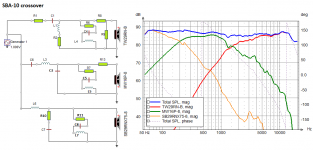
If you look at 200Hz level and lower it's about 2dB hotter than 400Hz-1200Hz. In return, 400-1200Hz is also about 2dB hotter than 1200 and beyond.
What does this means ?
Since lower in frequency we go, we get less directivity untill the sound becomes omni, this means that the level of lower frequencies doesn't fall off axis as fast as it happens to higher frequencies. This makes 200Hz and lower to remain loud and becomes louder in regard to higher frequencies as you go off axis. That's where so much bass comes from. Midrange directivity is not constant also and it also falls off slower at lower frequencies in regard to higher. Same applies for the tweeter. All this leads to bass heavy, dark sound.
Now, you'd think that TG doesn't know what he's doing, right ? Wrong. It's not what he does but more where he does it. In Scandinavia wooden houses are quite usual, while in East Europe they are almost exclusively made out of brick and/or cinder block.
This kind of voicing is usual for lossy wooden walls that flex and absorb much of that energy down low or for a very large listening room. Put this speaker in a classic British or East Europen house/apartment made out of hard materials and add few walls in close proximity to the speakers and it will be mayhem with bass.
For frequency response that suites smaller rooms (under 30 sqm) made out of hard materials one should turn to Kef voicing. Not letting the woofer dig much lower than 35Hz is preferable. If you have really good listening room or just can afford to place the loudspeaker where ever you want in the room, then full 6dB baffle step design is the most you can afford to do, usually it gets to about 4dB. Troels did 8dB baffle step here and it shows on measurements and in listening also.
Looking at this measurement i could bet that Troels listened and tweaked this speakers in house with drywalls or wooden walls.

If you look at 200Hz level and lower it's about 2dB hotter than 400Hz-1200Hz. In return, 400-1200Hz is also about 2dB hotter than 1200 and beyond.
What does this means ?
Since lower in frequency we go, we get less directivity untill the sound becomes omni, this means that the level of lower frequencies doesn't fall off axis as fast as it happens to higher frequencies. This makes 200Hz and lower to remain loud and becomes louder in regard to higher frequencies as you go off axis. That's where so much bass comes from. Midrange directivity is not constant also and it also falls off slower at lower frequencies in regard to higher. Same applies for the tweeter. All this leads to bass heavy, dark sound.
Now, you'd think that TG doesn't know what he's doing, right ? Wrong. It's not what he does but more where he does it. In Scandinavia wooden houses are quite usual, while in East Europe they are almost exclusively made out of brick and/or cinder block.
This kind of voicing is usual for lossy wooden walls that flex and absorb much of that energy down low or for a very large listening room. Put this speaker in a classic British or East Europen house/apartment made out of hard materials and add few walls in close proximity to the speakers and it will be mayhem with bass.
For frequency response that suites smaller rooms (under 30 sqm) made out of hard materials one should turn to Kef voicing. Not letting the woofer dig much lower than 35Hz is preferable. If you have really good listening room or just can afford to place the loudspeaker where ever you want in the room, then full 6dB baffle step design is the most you can afford to do, usually it gets to about 4dB. Troels did 8dB baffle step here and it shows on measurements and in listening also.
Looking at this measurement i could bet that Troels listened and tweaked this speakers in house with drywalls or wooden walls.
Last edited:
- Home
- Loudspeakers
- Multi-Way
- New SB Acoustics 3 way from Troels
